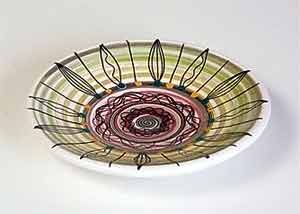
Cinque Port dish

Cinque Port dish
See also:
Cinque Port dish - 4¾" (120 mm) diameter. 1956/7.
Sharp, David
David Sharp was born in 1932 in Hackney, East London. The product of a broken home, he was taken in charge of the church and when he was eight was sent to foster parents in Sutton Valence, Kent. They were caring parents, who noticed his talent for art and decided that he should go to art school when his conventional education was finished. Duly he enrolled in a two-year foundation course at Maidstone School of Art.
During a summer holiday he visited the charming little town of Rye, just over the Kent border in Sussex. He saw the Rye Pottery and his interest in ceramics was born. In 1947 he became Rye Pottery's first apprentice. He worked for them for six years, learning the necessary skills for a potter, before being called up to serve his country in the army. During his National Service his talents as a boxer and as a musician came to the fore.
When he returned to the pottery two things had changed - the pottery and him. Rye Pottery had grown and become more commercial, concentrating less on studio pottery and more on commercial runs, and David had seen a lot more of the world. He had itchy feet and in 1956 left to form Rye Art Pottery, which later became Cinque Port Pottery, (note singular 'Port'), with his friend George Gray.
When the partnership dissolved, David stayed at the existing Cinque Ports Pottery (which had now become plural) premises at The Mint. David's new company was named the David Sharp Pottery.
Further Reading: |
The Potteries of Rye, 1793 onwards by Carol Cashmore |
Cinque Ports Pottery
David Sharp left Rye Pottery in 1956 and formed Rye Art Pottery with his friend George Gray.
The name had to be changed, though, when Rye Pottery threatened legal action. They asserted, probably quite correctly, that customers would be confused by the similarity of the two names and not know whom they were buying from. Consequently Rye Art Pottery became Cinque Port Pottery.
The business was successful. George was the businessman and David the artist, and their combined talents produced a thriving company. In 1958, after the closure of Dicker Pottery, they bought the trade mark. They didn't use it, but more to the point, neither did anyone else.
By the start of the sixties they were using four kilns and employing 15 workers. The partnership became a Limited Company, with another small change of name. They became Cinque Ports Pottery Ltd. The plural 'Ports' was used because that is what most people called them, being more familiar with Cinque Ports as a collection of towns rather than a particular constituent part of the collection.
Despite the success of the company, George's businesslike inclinations didn't match David's artistic and unconventional temperament, and in 1964 they agreed to part company. David helped to acquire new premises for George, and stayed himself at the existing Cinque Ports Pottery premises at The Mint. The two men stayed good friends for the rest of their lives.
George, who retained the Cinque Ports name, settled into his new premises, The Monastery, and started doing the things he found impossible when working with David. He made domestic wares that would sell in quantity, along the lines that Rye Pottery were using. George bought a small pottery in Stoke on Trent to supply biscuit ware to Cinque Ports; space was limited in The Monastery and he thought this would solve the problem. The venture was not a success, though, due to transportation problems.
The business expanded and was successful into the eighties, by which time George was growing old. He had other business interests - a restaurant, and later a gift shop - and decided that it was time to hand the pottery over to a younger man. Jim Elliot took over, trading as Cinque Ports Pottery, without the 'Limited', and later Cinque Ports Ltd, without the 'Pottery'.
The pottery closed in July 2007.
Further Reading: |
The Potteries of Rye, 1793 onwards by Carol Cashmore |


